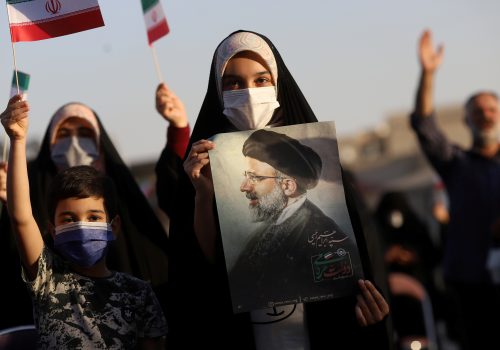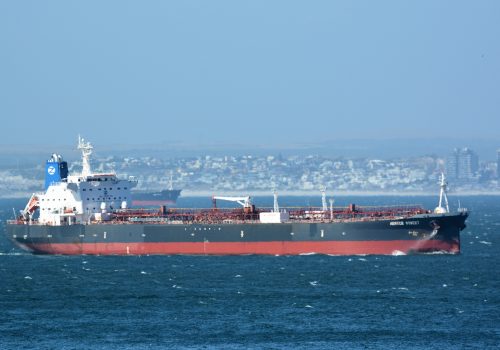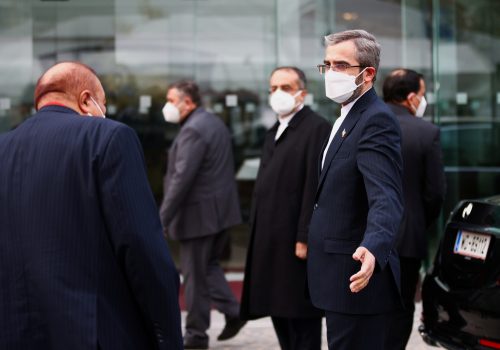Under Ebrahim Raisi, Iran and Turkey may be entering a new phase of bilateral ties
The relations between Iran and Turkey have been characterized by recurrent patterns of amity and enmity in the past two decades. Despite divergent foreign policy priorities and conflicting interests, the two regional powers have managed to compartmentalize their relations by handling geopolitical and economic issues in isolation from each other. With ultra-conservative Ebrahim Raisi holding power in Iran, this compartmentalization strategy is expected to continue to determine the future direction of bilateral ties.
On November 15, 2021, Turkey’s Foreign Minister Mevlut Cavusoglu met Raisi and his Iranian counterpart, Hossein Amir-Abdollahian, in Tehran, where they deliberated over economic relations, concerns over their shared border, and ongoing developments in the region. In a joint press conference with Amir-Abdollahian, the Turkish foreign minister talked about the two countries’ willingness to work on “a roadmap for a long-term comprehensive cooperation upon Iran’s proposal.”
Two weeks later, on November 29, 2021, the presidents of Iran and Turkey met for the first time on the sidelines of the 15th Economic Cooperation Organization summit held in Turkmenistan. During the meeting, the two countries signed a memorandum on a comprehensive improvement of bilateral relations and agreed to convene the seventh meeting of the High Level Cooperation Council during Turkish President Recep Tayyip Erdogan’s next visit to Tehran.
With the ascendency of Raisi in Iran, it has raised hopes that a new chapter in ties between Iran and Turkey may be opened. This follows the new president’s “Neighbors First” policy, which is aimed at reducing tensions between Iran and its most immediate neighboring countries, such as Saudi Arabia and the United Arab Emirates (UAE). Meanwhile, President Erdogan is also seen as engaging in a reset as part of his regional “charm offensive” with Egypt, Saudi Arabia, and the UAE.
While it appears that Iran and Turkey are reconciling their differences and developing strong bonds, the realities determining the future direction and dynamics of bilateral relations are far more complex.
Turkish-Iranian ties over the years
Broadly speaking, relations between Iran and Turkey over the past two decades can be divided into four main phases. In the first phase (2001-2010), Tehran and Ankara’s friendship grew stronger as a number of developments—such as the US war in Afghanistan, Turkey’s mediatory role in Iran’s nuclear file, and the 2010 Mavi Marmara aid flotilla incident—provided the impetus for the duo to align together conspicuously. In the second phase (2011-2015), the patterns of amicable bilateral relations were replaced by a period of intense geopolitical rivalry, mostly due to the 2011 Arab uprisings and the ensuing Syrian civil war. In the third phase (2016-2017), relations showed signs of improvement as a result of Iran’s opposition to the 2016 failed coup attempt in Turkey, the mutual condemnation of the Iraqi Kurdistan Regional Government’s passage of a controversial independence referendum in 2017, and the formation of the Astana Peace Process on Syria. In the fourth phase (2018-present), the relations between the two countries have vacillated between cooperation and conflict, mainly because of the tensions over Syria, Iraq, and the South Caucasus.
Syria remains a bone of contention as the fate of northwestern Idlib province is uncertain. Turkey’s military offensives in the last major rebel stronghold of Idlib since October 2017 have reinforced the patterns of competition between Iran and Turkey. Iran-backed militias clashed with Ankara-backed forces in late February and March 2020 in Idlib province. Although the situation in Syria has evolved into a “frozen conflict,” the unstable equilibrium in Idlib has turned the province into a tinderbox.
In addition, northern Iraq—particularly the disputed Sinjar district—remains a focus of immense geopolitical rivalry between external actors, most notably between Iran and Turkey. In Sinjar, Iran is using its Shia proxies to entrench their military presence, whereas Turkey seeks to get the Kurdistan Workers’ Party—recognized as a terrorist organization by the US, European Union, and Turkey—and Iran-backed militias out of the disputed district.
In the South Caucasus, where the status quo was changed in favor of Turkey and Azerbaijan due to the second Karabakh War in 2020, both Iran and Turkey are seen competing for a greater economic and geopolitical footprint. As a direct consequence of the conflict between Azerbaijan and Armenia in 2020, Iran has increasingly-limited room for geopolitical maneuvering north of its border, while Turkey has gained a land corridor that connects Azerbaijan with Nakhchivan to the detriment of Iran’s regional interests.
Despite the volatile situation in the three zones of conflict cited above, the compartmentalization strategy still remains relevant. In other words, the current state of affairs between Tehran and Ankara can be characterized as a form of conflictual cooperation, with economic issues and geopolitical rivalries acting as a guiding principle that prevents the negative spillover of certain disagreements into areas of bilateral cooperation.
In the realm of economic ties between Iran and Turkey, although the trade volume is far behind the targeted goal of $30 billion—standing at a meager $3.4 billion in 2020—the fact remains that a compartmentalization strategy has helped the two countries to develop a transactional relationship guided not by a durable strategic partnership, but by short-term pragmatism and realpolitik.
Having said this, while compartmentalization is likely to regulate bilateral ties between Iran and Turkey for at least the foreseeable future, the durability and success of this strategy have yet to withstand the test of time. Put differently, just because Iran and Turkey have managed to act based on the principle of compartmentalization in bilateral ties, this doesn’t necessarily mean that the list of disagreements over regional spoils will be a short one.
The compartmentalization strategy
Whether the compartmentalization strategy succeeds will also depend on the outcome of the détente between Iran-Turkey and the United Arab Emirates-Saudi Arabia, respectively. Four rounds of talks have been held in Baghdad since April 2021 to defuse tensions that first sparked in January 2016, when Iranian protesters attacked Saudi Arabia’s diplomatic missions in Tehran and Mashhad following the execution of a Saudi Shia cleric. In the latest sign of rapprochement between Turkey and the UAE, Erdogan and Emirati Crown Prince Sheikh Mohammed bin Zayed met in Ankara on November 29, 2021 and signed several cooperation and investments deals. Similarly, in a further sign of de-escalation of tensions between Tehran and Abu Dhabi, Tahnoun bin Zayed, the UAE’s national security advisor, met with high-ranking Iranian officials in Tehran in early December 2021.
The conciliatory gestures between Iran-Turkey and the UAE-Saudi Arabia mean that the region appears to be witnessing a vertical rapprochement, as Tehran’s and Ankara’s reset with Gulf Arab states help “depressurize” the Middle East, particularly the Persian Gulf region. Nevertheless, that is not to say that tensions in the Middle East have subsided.
The salience of this argument is that just as both Iran and Turkey seek to bury the hatchet with their Gulf Arab neighbors, it is likely that their regional rivalries heat up anew. This is simply because the potential depressurizing effects of a Tehran-Riyadh détente may result in further aggravation of geopolitical competition between Tehran and Ankara somewhere else in the region.
However, it remains to be seen whether talks between Iran and Saudi Arabia will lead to the aforementioned direction. Nevertheless, the outcome of Iran’s and Turkey’s negotiations with the UAE and Saudi Arabia will have important implications on their bilateral ties.
Another significant factor that adds an additional layer of complexity to Turkey-Iran relations is the Joe Biden administration’s decision to decrease the United States’ military footprint in the region. Given that the US has reverted back to the policy of “offshore-balancing” and the Middle East and North Africa is absent a power with order-making capabilities, the likelihood of Turkey and Iran further penetrating zones of conflicts will increase.
While Iran and Turkey may have too many geopolitical differences, both are expected to maintain their compartmentalization strategy so that divergences of interests at the regional level do not irreparably harm the core of bilateral relations.
Hossein Aghaie Joobani is a PhD candidate at the Department of International Relations, Dokuz Eylül University, Turkey. Follow him on Twitter: @Haghaie.
Further reading
Tue, Jun 29, 2021
If Raisi wants to improve the Iranian economy, price controls are where to start
IranSource By Amin Mohseni-Cheraghlou
Lawmakers and government officials in Iran repeatedly revert to the same set of failed populistic economic policies, failing to make short-term sacrifices that benefit the country in the long term. One such policy is price controls, a favorite in the toolkit of Iranian policymakers, who have attempted to control persistently high inflation rates over the past decades, but obviously with no success.
Wed, Sep 1, 2021
An escalating Israel-Iran conflict could sink the JCPOA
IranSource By
Rising tensions between Israel and Iran have reached an alarming stage in recent weeks. What used to be a shadow war of covert operations, sabotage, and proxy conflict is turning into a more direct military confrontation between the long-time regional adversaries.
Tue, Jan 11, 2022
Who’s on Iran’s current nuclear negotiating team? Some have controversial pasts.
IranSource By
As nuclear talks in Vienna continue their halting progress, a look at the backgrounds of the key members of the Iranian negotiating team may help explain why it has been so difficult to revive the 2015 JCPOA.
Image: A worker walks past the pumping station on the border between Iran and Turkey during the innauguration ceremony for the Iran - Turkey gas pipeline REUTERS/Raheb


